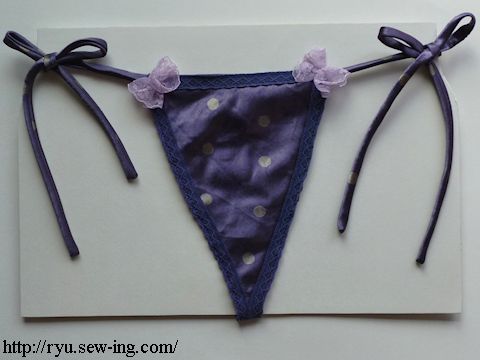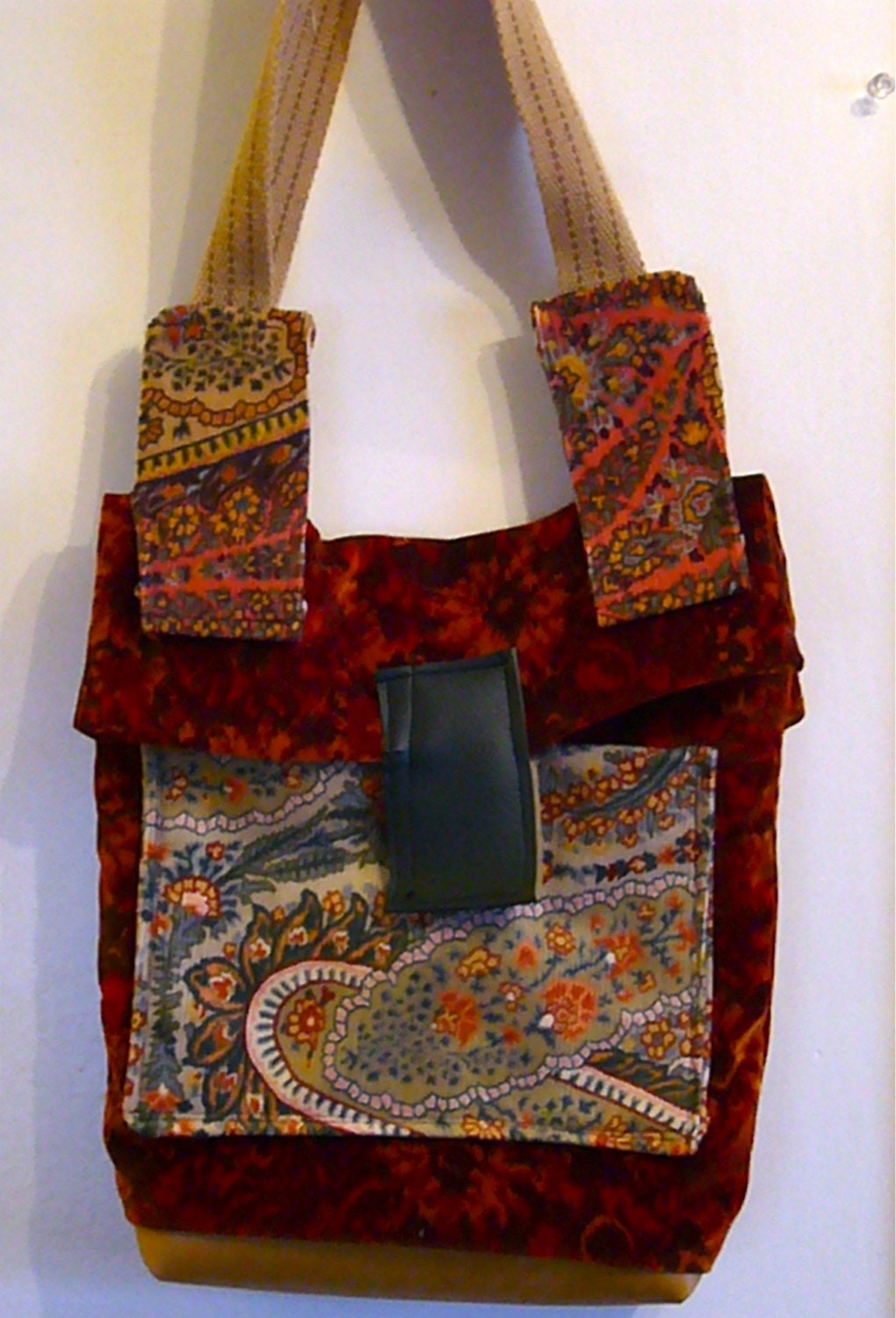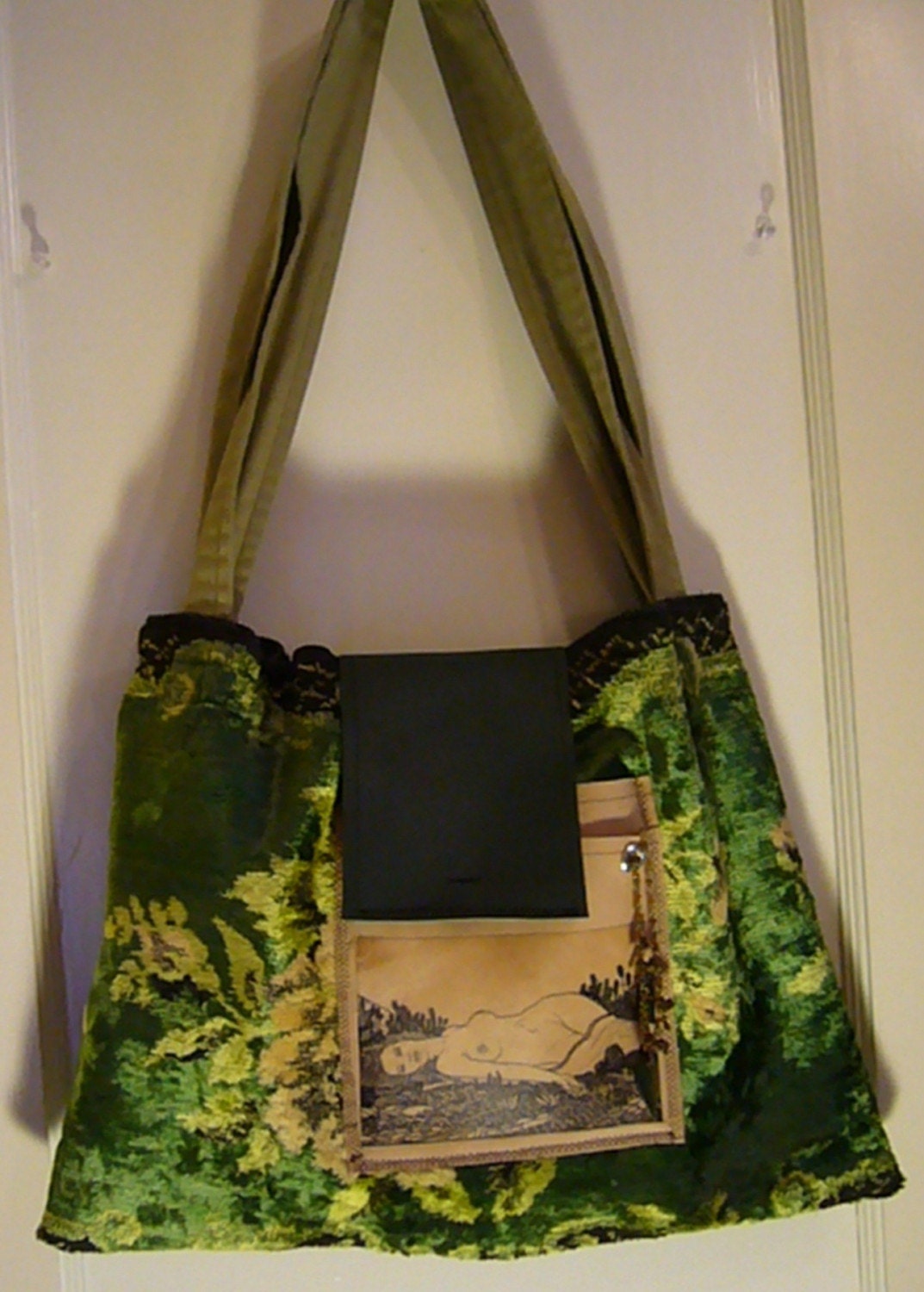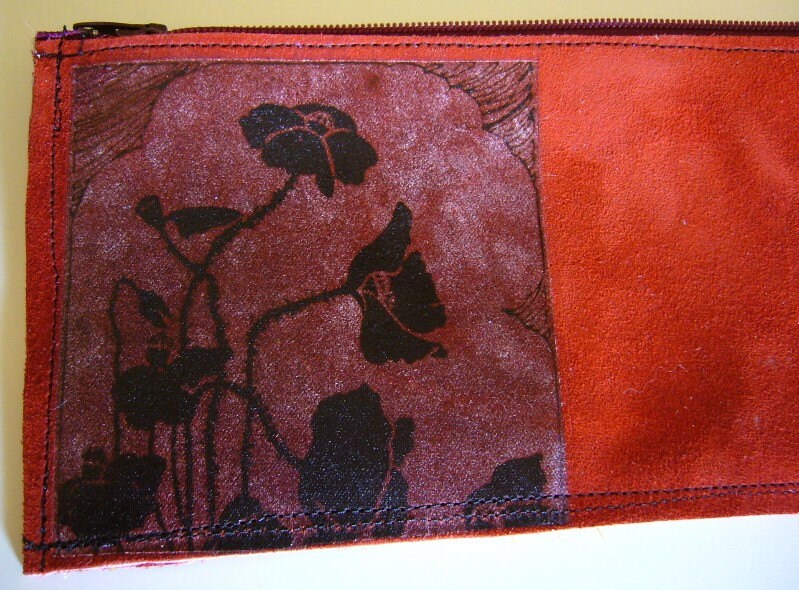Tuesday, July 6, 2010
like a caterpillar.....
Friday, July 10, 2009
UPCYCLING

 Here is a purse I made from upcycling materials I got at the re:use market here in Boise, thrift stores, and friends.
Here is a purse I made from upcycling materials I got at the re:use market here in Boise, thrift stores, and friends.I know a lot of people who are interested in eco-living, and every time I mention upcycling they ask me: "What's upcycling?" I say, "It's taking something that you would otherwise throw out and finding a way to make it into something else."
But then I started wondering where the term came from and if it was possibly a little more complicated than repurposing things. So I started digging, and this is what I found out about upcycling...
Upcycling is taking waste and making it into something that has equal or greater use or value. "Isn't that the same as recycling?" I asked myself. As it turns out, no.
The term was first used by William McDonough and Michael Braungart in their book Cradle to Cradle: Remaking the Way We Make Things. McDonough and Braungart compared upcycling to the "downcycling" of recycling a plastic, for example, into a lesser grade plastic. To put it simply, downcycling reduces the quality of the materials, while upcycling maintains or improves the quality of the materials.
Keen entrepreneurs have built successful businesses on upcycling. Marty Stevens-Heebner founded Rebagz to make handbags out of juice packs and nylon rice sacks. Joey Santley and Steve Cox founded ReSurf.org to upcycle broken surfboards into asphalt filler.
* article written by naturally savvy
Sunday, March 29, 2009
Turn That Ratty Old Shirt Into A Sassy One
Alright, lets take a step back. I'm not trying to imply here that a ratty and stained shirt can't serve a purpose on its own. It most certainly can. Especially if you're a painter. Or if you do landscaping. Or anything else dirty on a regular basis. The green dilemma presents itself when you have shirts like this one lying around that aren't getting any use. Not only are they creating clutter, which isn't any good, but they're not living up to their full potential if you'd wear the shirt more if it were altered. And alterations are easy to make, even if you've only got a pair of scissors handy.
If you want to turn your old shirt into a cute vest with ties, follow these simple instructions:
1. Take an old shirt and cut off the sleeves.

2. Cut off the collar and create a deep half-circle neckline.

3. Cut a rectangle of fabric out from the shirt, directly down the middle. The tighter you want the vest to eventually be, the wider this section cut out should be. Cut holes down each side of the vest, directly across from each other.

4. Use the fabric you've already cut out to cut strands of fabric. Use these strands of fabric to tie your holes together all the way down the vest.

Enjoy! There are so many things we can do with an old t-shirt which help us to avoid unnecessary waste and prevent unnecessary consumption simultaneously. Before you buy your next new shirt, make sure you ask yourself what you're doing with your old shirts.
* Photos courtesy of Elizabeth Seward
Sunday, March 15, 2009
10 Ways To Re:use A Necktie

one of my favorite things to use as straps in a lot of the bags and purses i make are neckties. i love the patterns and i love the way they feel.
here are some other fab things you can do with them:
Guitar Strap
- Needlepointers suggests turning an old necktie into a guitar strap. They warn that this will probably only work with smaller guitars. But why not banjos or ukuleles?

- A Thong Bikini


Craftster has found a way to turn a necktie into a woman’s bikini bottom. Jennifer Aniston was recently photographed in just a tie, but she wasn’t wearing the tie as pants. - A Snake Door Draft Catcher
Galoosh on Thriftyfun came up with this idea. Galoosh says, “Unstitch the narrow end of the tie and stuff the center with batting or other filler. (Most ties will require reinforcing of the opposite pointed wide.) Stitch it closed! Then take the wide pointed end of the tie and glue on eyes and a felt tongue. Voila`! Instant Snake Door Draft Catcher.” Reducing drafts can save on your energy bills and help the old planet. - Belts
Almost every website about tie-reusal suggests that the old tie be used as a belt for pants. I will repeat this tip one more time. Ties can be reused as a belts. - Quilt
About.com has a recipe for a quilt made from ties. It looks pretty snazzy. - Make a Bag
Craftbits has a great article on how to make a bag out of neckties.
- You can reupholster a chair with neckties
Home envy has some great tips for upholstering with neckties. - Skirts
The DIY network has a piece on how to make a skirt out of neckties. - Make a Necktie Coffee Sleeve
Keep your hand cozy with a necktie coffee sleeve by DIY life. - Necktie Tampon Cozy
Crafter came up with this so your tampons can stay cozy.
Friday, February 20, 2009
Strategies for Throwing the Perfect Clothing Swap

*photo of my friend Patty's B-day clothing swap (i'm far to the left sitting on the floor)
What You Need to Know for Successful Clothing Swaps
- Play hostess
You're putting together a party: make it feel like one. Give people plenty of notice, and send out actual invitations (even they're electronic) instead of doing word-of-mouth. Make sure you have food and drinks available—we all know shopping is exhausting!—and put some thought into your guest list: if all your friends have the same style, you might just end up with eight nearly-identical black blazers that no one is willing to pick up; on the other hand, if none of your invitees have even remotely similar tastes, then it might make it hard for everyone to find new pieces they love. - Get organized
A huge pile of clothes on the bed, stacks of shoes in the corner, and a jumble of necklaces on the dresses isn't doing anyone any favors. Set up different shopping areas—use a bar or rack for hanging dresses, a table for folded t-shirts and sweaters, a peg board to hang jewelry, and a long space (like a hallway) to keep those shoes in line, with plenty of mirrors throughout. Then develop a system: whether you want to organize by occasion—work wear, formal, casual—color, size, or designer, just pick a format that makes sense to your friends and go with it. - Set some ground rules
You don't have to be bossy about it, but specific guidelines about what people should bring will save you all a lot of hassle on the day of the swap. Some are just common courtesy: Items should be cleaned—dry cleaned, if necessary—and in good condition, without holes, rips, or stains. But others are more your call: what if a giver changes her mind after one of her items has been chosen? What will you do if your friend thinks it's unfair that she brought Burberry while everyone else brought Isaac Mizrahi for Target? What if two guests go for the same item? Better have a tiebreaker at the ready. And it doesn't hurt to have the name and number of a good tailor on hand, either, especially if it means your size 2 friend can go home with that size 6 dress and not think twice. After the party, plan to donate anything that wasn’t chosen to your local Goodwill or Salvation Army. - Keep thinking
Now that you're a pro at swapping your own clothes, think bigger: what about setting up a swap for baby and kids clothes? Hand-me-downs are a right of passage for them, and you'll be glad you saved money on a dress she wore once before outgrowing it. You could also take the process one step further and swap books, movies, board games, home decor (like throw pillows or framed prints)—and, of course, set up a time to swap back if you'd prefer these only be temporary lends. Bringing in something that's new to you gives you the same thrill as a daylong shopping spree, but without the same damage to your budget.
Wednesday, February 11, 2009
Top Fashion Accessories Tips
- Pick a good vintage
The second of the three Rs, "reuse," is there for a good reason--granting an existing item a second lease on life, instead of purchasing brand new, means no new manufacturing resources had to be tapped into. As a bonus, we're spared from any additional pollution and carbon emissions.
- Make it a fair trade
Shelling out for fairly traded gear supports fair labor conditions and workers' rights, especially in developing countries. Helping producers get a fair price for their labors and promoting self-reliance also empowers them to break the cycle of poverty they're often caught in. Just keep in mind that trade, not aid, is the answer to improving livelihoods everywhere. - Re:purpose for a purpose
Because the mining of precious gems and metals from the earth is an environmentally ravaging process, some jewelry designers have been taking a different, more eco-friendly tack. Recycled metals have been making their rounds of late, including a form of silver that is reclaimed from used photographic film. For your green wedding: engagement and wedding rings made from recycled gold and set with repurposed or lab-grown gems.
- Suss out sustainable
Accessories made from sustainably produced or recycled materials are lovely to behold and kind to the planet. On the fabric front, choose textiles such as organic cotton, hemp, bamboo, and even soysilk. - Beg or borrow
Plunder the contents of someone else's closet—with permission, natch—instead of shopping for your own. One company, Bag Borrow or Steal, even lets you rent as many as five designer handbags, belts, or pieces of jewelry at a time for a flat monthly membership fee (plus an additional fee per borrowed item). You can sate your desire for straight-off-the-runway ensembles without overtaxing the planet's resources. - Buy conflict-free
Conflict or "blood" diamonds are sold, often illicitly, in war zones and used by rebel movements to fuel conflict and human-rights abuses in countries such as Angola, Cote d'Ivoire, the Democratic Republic of Congo, and Sierra Leone. Make sure your diamond retailer can provide paperwork or otherwise prove that the diamonds are conflict-free. - Take care of your wares
Repair a torn purse strap or restring a broken necklace instead of consigning slightly damaged goods to the rubbish heap. Treating your accessories with a little TLC will also go a long way to extending their longevity, which is kinder to the environment than running through a series of semi-disposable replacements. - Brevity is the soul of wit
Accessories are meant to complement your outfit, not take it over. And, anyway, wouldn't you rather be remembered for your sparkling wit rather than that blinding hunk of ice that was weighing your neck down? Jewelry that is simple and classic will stand you in good stead, regardless of the occasion—or decade, for that matter. Which brings us to our next point. - Don't go with the flow
Pilot your own fashion destiny and unchain your heart from the vagaries of fashion trends. Being a follower instead of a leader will only bring you to a dark place filled with tears and the gnashing of teeth, plus a closet and dresser full of dated gewgaws and doodads that have long fallen out of favor with the fashion gods. One word: poncho.
- Buy indie
Think of "mall" as a four-letter word. Instead of shopping at a big-box retailer, which is likely to cut corners by purchasing from sweat shops, undercompensating employees, and cheapening quality, check out the offerings of one of the thousands of indie crafters bringing their creative talents to market. Because craft businesses tend to be small one- or two-person operations, their carbon footprints are infinitely smaller to those of multinational retailers such as Wal-mart or Kmart. By supporting independent artisans, you're also taking a stand against the onslaught of crass commercialization and unmindful consumerism. Viva la revolution!
Monday, August 11, 2008
soft like a baby's bottom...hee-hee


i found some great quilted place mats at savers (thrift store) and when combined with my re:use stash i came up with these soft purses for my collection of fabric (eco-friendly) bags. chosen for their bright colors there's something very comfy-cozy about them. i love them!
the green blackbird purse has a strap made from a white/green/tan striped canvas belt, which i printed a tree on. the inside and outside of the purse has pockets made of reclaimed suede and the exterior decorated with a blackbird and flowers (kept closed with velcro). the purse closes on top with a silk cord and big vintage button.
dimensions: 12" x 8" and strap is 22"
the sunshine purse is a soft yellow omelet shaped bag and it's strap is made from a vintage silk necktie. the inside is a brown floral pattern and outside is a bright yellow (w/ white polka-dots) with it's resident skunk smelling some flowers.
dimensions: 13" x 7" and strap is 22"
they are both oh-so perfect for holding everything you need and more...beautiful, sturdy, washable and eco-friendly!!!

